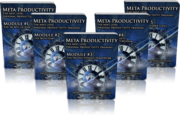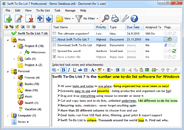There is no dispute that preparation is the key to success, and the same principle holds true for increasing productivity. Such a conclusion shouldn’t surprise you; it would be difficult to expect a job well done if you don’t have the right tools at your disposal. And while accruing resources – a subject for another blog post – is a key component of preparation, one aspect is often overlooked: getting into the zone. The zone, referred to as “The Ready State” in David Allen’s Getting Things Done: The Art of Stress-Free Productivity, is not a physical place but a mentality, a mind-set that is just as important a resource as your word processing software or earplugs to insulate you from your cubicle neighbor’s snoring after lunch.
Although you may not need to be in the Ready State to do work, it is a definite prerequisite for Getting Things Done. This is because GTD is focused on achieving your ideal level of productivity and efficiency; likewise, the Ready State is an ideal psychological environment. As Allen notes, this state will help you get more done with less effort; the Ready State is “a condition of working, doing and being in which the mind is clear and constructive things are happening.”
Thankfully, the Ready State is achievable for anyone and can be reached more easily than you might expect. To reach this zone, you need to do three things (and Swift To-Do List can certainly help):
- Understand the Task
- Eliminate Distractions
- Embrace the Task
So, let’s look at these in detail:
Understand the Task
The first step to reaching the Ready Zone may seem like the most obvious, but it is also the most frequently overlooked. In order to Get Things Done, you need to know what the things are. However, this step entails more than just reading the subject line of an assigning memo. Rather, you need to engage in PREP:
- Figure out the Priority
- Identify Resources that are required
- Identify End goals
- Acquire proper Perspective
While the PREP factors are relatively self-explanatory, a brief explanation can help eliminate misunderstandings. Assessing the Priority should be simple, as it’s often explained to you by your supervisor. If it isn’t, ask; you should also ask other authorities for whom you have assignments where the new task falls into place with your existing assignments. Using the Task Type and Priority fields in Swift To-Do List 7 can ensure you don’t mistake the Priority.
Assessing and acquiring the Resources you need can be easy but time-consuming, and it’s important to forget that your best resources can include your coworkers and work you’ve already done. Obviously, there’s no need to redo work you’ve already finished, but even if your task is a completely new one, you may be able to enlist data or techniques from past work into your new assignment.
Your End goals will determine what exactly you do and how you go about doing it; do you have specific budget or time constraints? Or do you simply need to say, reach 10,000 Likes on Facebook by any means necessary? Be sure you know what the End goals are and what time frame you have to reach them.
Lastly, you need to adopt the proper Perspective; we explained the importance and methodology of this step in this post. Briefly explained, the proper Perspective is acquired by understanding where the task at hand falls in your workflow and the overall company objectives; see the task for what it is and don’t be overwhelmed; do only what you need to but never less than that.
Eliminate Distractions
Just as you might expect Understanding the Task to be the easiest step, you probably have an inkling that Eliminating Distractions will be the most difficult. And you’d be absolutely correct. Thankfully, difficult does not mean impossible, and over time you will tackle this task with increasing ease.
Eliminating distractions requires willpower, but it doesn’t require you to make sacrifices; instead, you can make compromises. Using Swift To-Do List 7’s inbuilt timer can help you set productivity goals – you can work on the task at hand for a specific amount of time before you take a break and then time your break to ensure you’re not wasting too much time. By setting out specific blocks of non-productivity, you will be less likely to get off task when it’s time to work.
Additionally, you don’t need to eliminate everything that could qualify as a distraction; listening to music, for example, can provide stimulation while you work on a task and help stave off boredom. It is up to you to assess what is distracting and what is not; common culprits include eating, chatting with coworkers, browsing the internet and multitasking.
See also 10 tips to create more productive environment at your desk.
Embrace the Task
Embracing the Task is what Allen describes as making your “mind like water,” or in simpler terms, going with the flow. This crucial step involves simultaneously letting go of everything else in your mind – work and family commitments, worries and expectations, etc. – and allowing your mind to focus simply on your assignment. Instead of thinking about what else you have to do, start thinking about how anything that does enter your consciousness can help contribute to your task. For example, if a coworker engages you in conversation, ask for feedback on what you’ve done so far. Or, if your computer crashes, let IT staff handle the task and outline strategies on paper.
Often, making the act of emptying your mind of internal and external commitments and refilling it with concerns relating to your assignment can help. Do this by typing out your non-assignment related commitments as a new to-do list in Swift To-Do List 7, and then fully concentrate on a separate to-do list for assignment-related needs. This can set your mind at ease and help you truly Embrace the Task at hand.
Another powerful technique is to utilize the task notes in Swift To-Do List to write down all the details related to the task. See more about this in 10 best tricks of fooling myself to work
Post by Brian J. Willet





